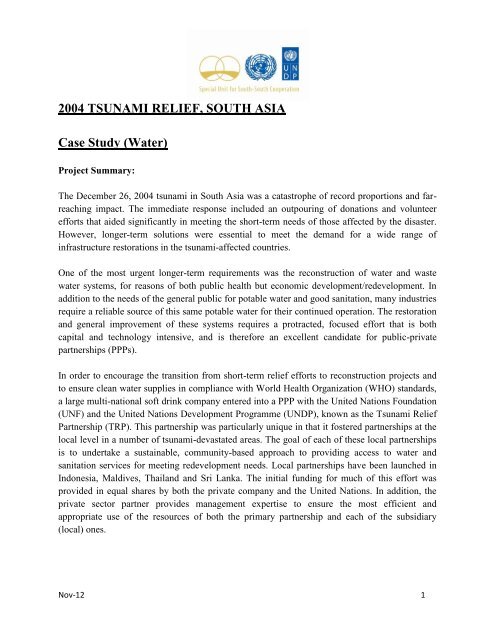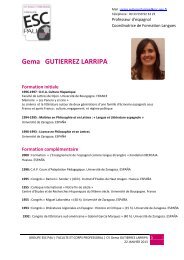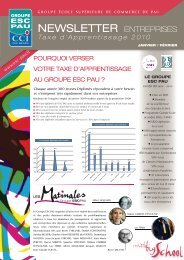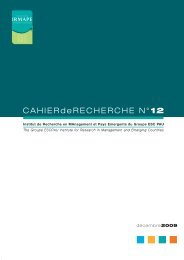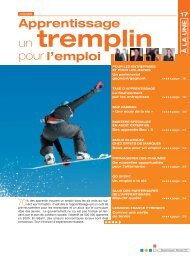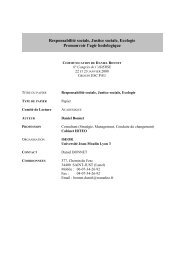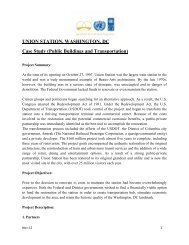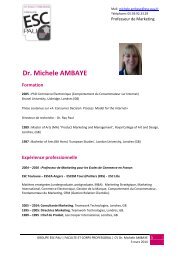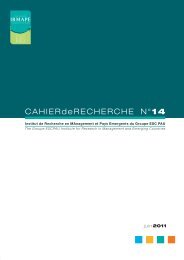2004 TSUNAMI RELIEF, SOUTH ASIA Case Study (Water) - ESC Pau
2004 TSUNAMI RELIEF, SOUTH ASIA Case Study (Water) - ESC Pau
2004 TSUNAMI RELIEF, SOUTH ASIA Case Study (Water) - ESC Pau
You also want an ePaper? Increase the reach of your titles
YUMPU automatically turns print PDFs into web optimized ePapers that Google loves.
<strong>2004</strong> <strong>TSUNAMI</strong> <strong>RELIEF</strong>, <strong>SOUTH</strong> <strong>ASIA</strong><strong>Case</strong> <strong>Study</strong> (<strong>Water</strong>)Project Summary:The December 26, <strong>2004</strong> tsunami in South Asia was a catastrophe of record proportions and farreachingimpact. The immediate response included an outpouring of donations and volunteerefforts that aided significantly in meeting the short-term needs of those affected by the disaster.However, longer-term solutions were essential to meet the demand for a wide range ofinfrastructure restorations in the tsunami-affected countries.One of the most urgent longer-term requirements was the reconstruction of water and wastewater systems, for reasons of both public health but economic development/redevelopment. Inaddition to the needs of the general public for potable water and good sanitation, many industriesrequire a reliable source of this same potable water for their continued operation. The restorationand general improvement of these systems requires a protracted, focused effort that is bothcapital and technology intensive, and is therefore an excellent candidate for public-privatepartnerships (PPPs).In order to encourage the transition from short-term relief efforts to reconstruction projects andto ensure clean water supplies in compliance with World Health Organization (WHO) standards,a large multi-national soft drink company entered into a PPP with the United Nations Foundation(UNF) and the United Nations Development Programme (UNDP), known as the Tsunami ReliefPartnership (TRP). This partnership was particularly unique in that it fostered partnerships at thelocal level in a number of tsunami-devastated areas. The goal of each of these local partnershipsis to undertake a sustainable, community-based approach to providing access to water andsanitation services for meeting redevelopment needs. Local partnerships have been launched inIndonesia, Maldives, Thailand and Sri Lanka. The initial funding for much of this effort wasprovided in equal shares by both the private company and the United Nations. In addition, theprivate sector partner provides management expertise to ensure the most efficient andappropriate use of the resources of both the primary partnership and each of the subsidiary(local) ones.Nov-12 1
Today, partnerships are underway in communities in all four countries to improve the quality ofwater supplies and public sanitation facilities, and to develop community-based water resourcemanagement and long-term water supply activities.Project Objectives:Those responsible for development programs, at both the international and national levels,agreed on the important role of the private sector in economic growth, job creation andcontribution to individual incomes. Domestic private sector development, vis-à-vis sustainablegrowth of micro, small and medium sector enterprises was therefore viewed as an essentialaspect of post-tsunami reconstruction. PPPs have become a vital mechanism for harnessing anddirecting resources to achieve these broad development goals and promote sustainable recoveryand development. The partnership between the global soft drink company and the UN fullyrecognizes these objectives, while focusing on specific development/redevelopment needs drivenby the catastrophic tsunami.This partnership seeks to achieve broad objectives that include:Recovery and rehabilitation of national entrepreneurial enterprises and generalrevitalization;Construction of infrastructure that has the ability to withstand the risk of future disasters;Incorporation of global codes and standards in the areas of reconstruction, includingdevelopment of local skills and capacity; andUtilization of demand-based sustainable water and sanitation solutions determined inpartnership with the local stakeholders for each project, to include the affectedcommunities, the UNF and UNDP, and the soft-drink firm's local bottling companies.Nov-12 2
Project Description:1. Underlying PhilosophyIt was fully realized that for the TRP to achieve global and national goals, implementation had tobe done at the local level. The TRP set out to establish a framework for a series of localpartnerships and to create an environment that would remove barriers to implementation of thesepartnerships. Key to this is the understanding that smaller and community-based enterprises mustbe included. Examples learned from earlier, failed development efforts had to be considered, andthe lack of experience, public awareness, and public-sector capacity in implementing PPPs hadto be addressed to create an environment in which this mechanism would have a greaterlikelihood of success. Successful PPPs would then be the mechanism through which resourceswere developed, allocated, managed and delivered to those left most in need by the tsunami.The driving purpose behind the TRP was to promote sustainable water and ecological sanitationcapabilities in selected tsunami-affected areas. This partnership,, in addition to mobilizingfinancial resources, provided the opportunity to leverage the tremendous non-financial resourcesand combined capacity of the UN and the private partner (both globally and locally). Inadditional, the partnership aimed to build upon and explore linkages with relevant UNDPexperiences and community-based programs already in place with local governments in theselected countries to address post-tsunami recovery. This ensured that the recovery andrehabilitation process had local participation and met the demands of the individuals andcommunities receiving the services. For this reason, the private soft-drink company agreed toprovide not only capital but also in-kind management assistance and coordination with theUNDP country offices and recovery teams to ensure that the individual partnerships met theneeds of the specific countries and localities targeted by the TRP.2. Basic Framework for Local PartnershipsAn initial framework for guiding the potential needs for water and sanitation services of thepopulations affected by the tsunami was agreed upon by all the partners, through the TRPagreement. This included agreement on the following framework:The primary focus would be on community-based sustainable water and sanitation withan emphasis on enhanced access to these services by the general public;There would be an emphasis on education, outreach and advocacy focusing on andengaging the communities;Nov-12 3
All activities must be demand driven, determined by national assessments and nationaldevelopment priorities and programs;The TRP would ensure participation in the programmatic activities by the relevantcountry, and local level teams, as well as the soft-drink company's affiliates in order toenable leveraging of non-financial resources and the combined capacity of all the TRPpartners; andStrategic interventions would be used to balance the needs to urgently address water andsanitation requirements in the tsunami-affected countries and to contribute to a longertermfocus on service expansion of damaged water and sanitation infrastructure.Once this framework was agreed upon, visits to five Southeast Asian countries were undertakento assess the post-tsunami recovery needs in those regions. Not only did this assist the TRP inassessing the progress of the recovery and rehabilitation activities up to that point, it alsoexhibited the extent of the need for and the level of possible participation possible in localpublic-private partnerships in the specific countries.3. Selection of Target Countries for Local Partnership AgreementsThe TRP used the following criteria to select target countries for future partnership activities: Need and national demand for water and sanitation services in the recovery andrehabilitation phases; Expressed intent of the UN offices and the individual country government to engage withthe private sector in relief and recovery and rehabilitation phases; Need for additional resources, particularly in the provision of sustainable water andsanitation services; Willingness of the country's government and other stakeholders to participate in and takeownership of the activities; Ability of these stakeholders to deliver and implement program activities; Possibility of linking the proposed project activities for provision of water and sanitationservices with ongoing UN activities and making them sustainable; and Meeting with the interests of the private soft-drink company and its local bottlers.On the basis of these criteria, it was determined that the TRP would encompass partnershipefforts in Indonesia, Maldives, Sri Lanka and Thailand.At the outset of each local partnership, agreement was reached on the expected output,communication strategy, risks, management arrangements, monitoring and evaluation, reporting,Nov-12 4
characterization of contributions and the legal context. A detailed budget for each project wasalso developed.i. Expected OutputCountry-level activities are focused on providing tsunami-affected populations with communitybasedsolutions to improve access to sustainable water and sanitation services. The projectsengaged the local private bottling partners in identifying objectives and strategies to provideaccess to sustainable water and sanitation services for the populations that were most impactedby the tsunami disaster. Based on the on the in-country visits, specific outputs for each countrywere promulgated, but the overall expectations of the partnership activities were as follows:Stimulate the entire reconstruction and redevelopment process in the selected tsunamiaffected countries using sustainable water and sanitation as an entry point in an integratedstrategy for sustainable livelihoods;Generate public-private partnerships initiatives that can be replicated in other developingcountries;Address the reconstruction needs of the tsunami affected population, while creatingopportunities for long-term engagement of the private bottling company with the UNagencies and institutions;Generate pilot activities which will lead to generating partnerships with other UNagencies, other countries and additional areas, including education, creation ofentrepreneurs, and access to financial resources; andCreate possibilities to leverage additional resources for replication within the country andalso under south-south cooperation.ii. Communications StrategyThe TRP recognized that the innovative nature of the project called for the detaileddocumentation and wide dissemination of the lessons of the projects. To that end the TRPcreated and implemented a strategic communications strategy that would highlight the countrylevelexperiences at workshops, seminars and other forums. In addition, documentation includedfocused lessons that would be instructive in forming effective public-private partnershipstrategies for strengthening domestic private sectors in other countries.Nov-12 5
iii. RisksAlthough this project used a body of knowledge that is well known by the UN partners in thisproject, the process had not been previously applied specifically to post-disaster reconstruction.Additionally, the project was unique in that it relied on in-house expertise from various staffmembers at regional offices of the partners who would not be able to dedicate their total time tothe project activities. This, in conjunction with the planned used of external consultants andpartner organizations, made full coordination between all parties critical. Another risk was thereliance on the national political leadership and bureaucracy to provide momentum for thereconstruction and rehabilitation process. It was understood that the success of the partnershipactivities would be dependent on the ability of the national political and administrative processesto move forward and allow local public-private partnership activities to proceed. It was criticalthat the TRP coordinated its plans within the national priorities, reconstruction plans andguidelines developed by each target country.iv. Management ArrangementsThe proposed program was a part of the UNDP's global program to facilitate private sectorcapacities for development and was implemented and managed under pre-existing UN guidelinesfor projects of this nature. The Public-Private Partnership Programme of the UNDP providedoverall management and oversight of the program. Specifically, the <strong>Water</strong> Governance Team,the Public-Private Partnerships for the Urban Environment and an employee on loan from theprivate soft-drink company provided guidance and services for the project.v. Monitoring, Evaluation and ReportingThe standard monitoring, evaluation and financial accountability standards of UNDP globalprograms apply to this partnership. In addition to the ongoing evaluation of the TRP according tothese standards, each local partnership is subjected to an independent evaluation, which isbudgeted for at the outset of the local project. Bi-annual financial utilization, annual progressreports, annual certified or audited financial statements, final program reports and auditedfinancial statements are required in accordance with existing UN guidelines.vi. Charitable Contribution ClauseDue to the goal of the project to contribute to the rehabilitation of poor and distressedcommunities that were affected by the <strong>2004</strong> tsunami, all funds dedicated by the private sector toNov-12 6
the primary partnership and subsequent local partnerships are deemed charitable contributions.As a result, the soft-drink company is able to classify its contributions as tax deductible underUnited States tax law.vii. Legal ContextThe administration of the TRP is governed by UNDP rules and procedures. Each of the localpartnerships was governed by the statutes and regulations of the individual host country. It wastherefore necessary for each of the four countries participating in the PPP to have appropriatestatutory and regulatory provisions to enable the successful implementation on PPPs.viii. BudgetThe United Nations Foundation and the private soft-drink company each contributed $1 millionto the initial partnership. The private company also matched UNF employee contributions of$100,000 in a challenge grant. As a result, the total budget for the TRP is $2.2 million. Inaddition, the private partner also pledged $9 million in additional funds to be used inimplementing local public-private partnerships in the target countries. This brought the totalprivate sector contribution to $10,100,000 out of a total budget of $11.2 million.Nov-12 7
Local Public-Private Partnerships Fostered by the TRP by Country:1. ThailandIn 2005, TRP, the Chumchon Thai Foundation (a local NGO) and local communities launch apartnership for development to provide sustainable access to water in Thailand. The UNDP-ledproject is focused on the sustainable management of water resources on the island of Koh Lanta,in Krabi Province, Southern Thailand. Fresh water is limited on Koh Lanta, especially in the dryseason, and the stewardship of water resources is a key developmental issue. An enormousamount of fresh rainwater simply runs off the island into the sea. Existing water reservoirs andwells do not currently meet the water needs of the island's population, particularly during the dryseason. Implemented in collaboration with the Chumchon Thai Foundation, the project buildsupon and is part of a broader partnership between UNDP and the Government of Thailand tobolster the post-tsunami recovery of Koh Lanta.With funding from the TRP, additional funding support from the soft drink company, and theUnited Nations Foundation, the project is helping the tsunami-affected communities of BanSanga-U, Che Li, Hua Laem and Koh Por to plan, implement and maintain a series of activitiesto alleviate water shortage problems in their villages. This includes:Constructing 10 community check dams along the stream that runs through the fishingvillage of Ban Sanga-U on the southern tip of the island. These community check damsare now collecting and retaining rainwater, providing 117 village households with a longtermsupply of water.Constructing a gravity-fed water system (including a reservoir and sedimentation tank) inthe village of Hua Laem.The drilling of artesian wells on a nearby island reduced difficulties in terms of wateraccess and availability.Constructing an organic farming irrigation system in Che Li village on the western sideof the island for enhanced livelihood security.The project emphasizes constant community dialogue and active participatory planning. Local<strong>Water</strong> User Groups have been set up as a multi-stakeholder Project Steering Committee thatincludes local community leaders and government representatives.Nov-12 8
With a focus on the long-term sustainability of this initiative, project staff will also work withcommunities in Koh Lanta to build capability at the local level, providing training in basicaccounting, project monitoring, water distribution and maintenance skills.2. IndonesiaIn 2005, UNDP, UN-HABITAT, the private soft-drink corporation, the UN Foundation andPDAM (a municipal water provider) launched a partnership to provide sustainable access towater and sanitation services in Indonesia. This partnership project is supporting the rebuildingof the hard-hit Aceh region, where the freshwater system was severely damaged by the tsunami.Most of the shallow water wells and parts of the deeper wells were flooded by salt water orotherwise ruined by the preceding earthquake.In the first phase of the TRP work in Indonesia, the soft-drink company's Foundation Indonesiaprovided $300,000 in parallel funding to the German Federal Institute for Geoscience andNatural Resources (BGR) to help the Indonesian government obtain comprehensive hydrologicaldata on water resources in the Pidie district of Aceh. The helicopter-borne survey wascomplemented by additional electromagnetic and hydrological studies in the area. The resultsprovide the first-ever comprehensive mapping of freshwater supplies in the region.The second phase of the project now builds on the these results through a joint UNDP/UN-HABITAT initiative providing safe and regular water supply and sanitation facilities to sixvillages in the districts of Pidie and Aceh Besar. The activities have been financing throughmatching funds from the soft drink company and the UN Foundation.The project supports UN-HABITAT's "Aceh Nias Settlement Support Programme," a housingand community infrastructure program for tsunami-hit villages that links with UNDP's tsunamirecovery program in Aceh. Access for safe and regular water supplies is an extremely importantissue for villagers in this area. After intensive consultation with the village communities, UNDPand UN-HABITAT are collaborating with PDAM to provide clean water for rural households inthis coastal area. Due to limited capacity, PDAM had previously not been able to cover thesetsunami-affected villages. As such, the project is helping to build the capacity of PDAM torehabilitate water treatment plants in the area and extend its water supply network to six of themost decimated villages in the districts of Aceh Besar and Pidie. Each household is beingconnected to the new water distribution network, reaching approximately 7,700 people andgreatly improving sanitary conditions. This is the first time these villages have ever had access toNov-12 9
tap water for household use. Villagers have been closely involved in the project design anddirectly involved in the construction and implementation.As an entry-point for longer-term community empowerment, rainwater harvesting, publicsanitation facilities (including latrines, common waste disposal and wastewater drainagefacilities) and a hygiene and sanitation awareness component are also being implemented in eachvillage through this project.3. MaldivesIn 2006, UNDP, UN-HABITAT, UNICEF, the private soft-drink corporation, the UNFoundation, the Australian Agency for International Development, the Government of theMaldives and Dhambidhoo Island residents launched a partnership to provide environmentalsanitation on Dhambidhoo Island. The project is focused on the remote island community ofDhambidhoo, situated 228 km to the south of the capital, Male. Dhambidhoo Island was badlyhit by the tsunami disaster. Forty-eight houses were damaged and another twenty-nine weredestroyed. In addition, salt-water incursion exacerbated the vulnerability of the islandenvironment, meaning that full recovery of the freshwater resources is expected to take years.In support of UNDP's post-tsunami recovery program, the soft drink company, the UNFoundation and the Australian Agency for International Development have funded a muchneededwater and sanitation project on Dhambidhoo. When completed, this will be one of thefirst islands in the Maldives other than Male and the resort islands to provide sustainablesanitation services to all its residents.At the completion of this project, all households and public buildings will be fitted with adurable, water-tight septic tank and connected to a sewage network. Through this sanitationmodel, the effluent discharge from household septic tanks will be channeled safely through anetwork of pipes to a treatment plant and, after passing through a biological filter, will be usedfor irrigation or disposed to a soakage pit to recharge groundwater. This will bring an end to thepre-tsunami practice of discharging raw sewage directly into the island's lagoon or into thegroundwater. In this way, the project strongly supports the post-tsunami approach of "buildingback better."The project is being implemented in close partnership with local authorities, community leadersand the Dhambidhoo Island Development Committee to ensure continued local relevance, truecommunity ownership and sustainability.Nov-12 10
The new sanitation system will be managed by the community and will be both environmentallyand financially sustainable. Island residents will be provided with the necessary training andtechnical assistance to operate and manage the system in an effective manner. Provision ofadequate sanitation has been identified as a pressing national challenge and is an integralcomponent of the UN's post-tsunami Shelter Recovery Project, a joint collaboration betweenUNDP and UN-HABITAT. The "Dhambidhoo model" has been designed to be replicable inother island communities across the Maldives.4. Sri LankaIn 2006, TRP, local communities and local governments launched a partnership to providecommunity empowerment through water and sanitation in Sri Lanka. This local public-privatepartnership is providing essential water infrastructure and sanitation services to two separatetsunami-hit areas of the country: Kattankudi in the east and Kalupe in the south.i. KattankudiLocated in Batticaloa district in eastern Sri Lanka, Kattankudi is one of the most denselypopulated townships in Asia. Situated on a thin strip of land between the ocean and a largelagoon, the closely-spaced houses lack safe drinking water and basic sanitation facilities. Muchof the water is saline, there is no water table, and sewage often backs up into the houses. Thelack of infrastructure for water, sanitation and waste management results in poor health andenvironmental degradation. Pollution in the lagoon is also severely affecting fisheries-relatedlivelihoods.The project is supporting the most vulnerable members of the Kattankudi community throughaccess to improved water and sanitation services. The main component is the provision of asustainable sanitation and wastewater management system including septic tanks, soakage pits,bio-cells and a chlorine tank. Bio-cell technology has not been used in the east of Sri Lanka andmay prove to be a replicable, low-cost, community based solution to the sanitation and sewagedisposal needs of densely populated cities in the rest of Sri Lanka.As an initial pilot, this system is being implemented through local community-basedorganizations and provided to 19 of the most vulnerable households as part of a larger projecttargeting 7,000 people within the township. In addition to this integrated sanitation andNov-12 11
wastewater management system, rooftop rainwater harvesting units will be provided to each ofthe pilot households.ii. KalupeThe village of Kalupe, Hikkaduwa is located in the district of Galle, an area in the south of SriLanka that was badly hit by the tsunami. Through this project, a two kilometer pipeline is beingbuilt to connect the village of Kalupe to the Greater Galle <strong>Water</strong> Project to deliver safe drinkingwater to tsunami-affected people in and around the village.Beyond this permanent pipeline infrastructure, the community is being engaged through trainingand awareness-raising to monitor the implementation and jointly "own" the process - part ofUNDP's "Aid Watch" strategy to ensure transparency and accountability in post-crisis recovery.Community members in Kalupe will communicate and work directly with representatives fromUNDP, the UN agency implementing this project under the overall technical guidance of theNational <strong>Water</strong> Supply and Drainage Board. In addition to this "Aid Watch" component, bothprojects also include a focus on community training and awareness-raising on water, sanitationand hygiene practices, led by expert health and hygiene promoters.Commentary:The Tsunami Relief Partnership is unique in that it established a system for development andfunding of a number of local public-private partnerships to address multi-country, regionalproblems. Both public and private sector management skills and resources have been combinedto provide a guiding mechanism for the establishment of these individual local PPPs, whileensuring substantial involvement from local stakeholders in establishing the parameters for eachproject.While Corporate Social Responsibility was no doubt a component in the decision for the softdrinkcompany to undertake this partnership, there was also an economic benefit that would bereceived by the company. In addition to the tax deduction implications, there is a private sectorbenefit with the restoration of a potable water supply and waste water systems that aid incontinued operation of the local bottling companies. And finally, the visible and recurring goodwill toward the company generated by these may also provide some positive stimulation to itslocal markets.Nov-12 12
Of particular value is the objective of the TRP to create replicable models that could apply inalmost all developing countries. The sharing of resources of both the public and private sectors,both globally and locally is an integral part of this effort and a clear model for other possiblepartnerships to not only address catastrophes but also general infrastructure and service needs inthese states.Nov-12 13


